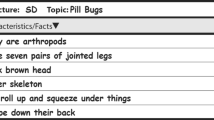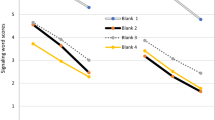Abstract
Informational text writing is a complex task requiring multiple literacy skills, such as reading and comprehending source material, identifying important information, and transforming ideas to meet the goals for the new writing task. The Structures Writing intervention was developed to improve the informational text writing skills of 4th and 5th grade struggling writers by reducing the cognitive load associated with reading source text and teaching students to organize information using text structures. In the current study, sixty-one 4th and 5th grade struggling writers were randomly assigned to receive the Structures Writing intervention. Students in the Structures Writing intervention were provided with information in “frames” and taught to write informational passages using three text structures (i.e., simple description, compare/contrast, sequence). To do so, the students were taught a strategy for picking the topic and structure of their writing, organizing facts for the text structure, and writing the facts in paragraph form. They were also taught to include text structure features, including signal words, transition words, grouping similarities and differences, etc. At post-test, students who received the Structures Writing intervention statistically significantly outperformed the control group on researcher-created measures of simple description writing (d = 0.66), compare/contrast writing (d = 0.61), and sequence writing (d = 0.94). Results also indicate students in Structures Writing intervention condition statistically significantly outperformed the math-writing group on a measure of identifying text structures in reading passages (d = 0.94). No other statistically significant differences were found between the groups. The implications and future directions for the development of the Structures Writing intervention are discussed.

Similar content being viewed by others
References
Archer, A. L., & Hughes, C. A. (2011). Explicit instruction: Effective and efficient teaching. New York, NY: Guilford Press.
Berninger, V. W., & Amtmann, D. (2003). Preventing written expression disabilities through early and continuing assessment and intervention for handwriting and/or spelling problems: Research into practice. In H. L. Swanson, K. R. Harris, & S. Graham (Eds.), Handbook of learning disabilities (pp. 345–363). New York, NY: Guilford Press.
Berninger, V. W., Vaughan, K., Abbott, R. D., Begay, K., Coleman, K. B., Curtin, G., et al. (2002). Teaching spelling and composition alone and together: Implications for the simple view of writing. Journal of Educational Psychology, 94, 291–304. https://doi.org/10.1037/0022-0663.94.2.291.
Breaux, K. C. (2010). Wechsler individual achievement test—third edition: Technical manual. Bloomington, MN: Pearson.
Brindle, M., Graham, S., Harris, K. R., & Hebert, M. (2016). Third and fourth grade teacher’s classroom practices in writing: A national survey. Reading and Writing: An International Journal, 29, 929–954. https://doi.org/10.1007/s11145-015-9604-x.
Costa, L. C., Edwards, C. N., & Hooper, S. R. (2016). Writing disabilities and reading disabilities in elementary school students: Rates of co-occurrence and cognitive burden. Learning Disabilities Quarterly, 39, 17–30. https://doi.org/10.1177/0731948714565461.
Duke, N. K., & Pearson, P. D. (2002). Effective practices for developing reading comprehension. In A. E. Farstrup & S. J. Samuels (Eds.), What research has to say about reading instruction (3rd ed., pp. 205–242). Newark, DE: International Reading Association.
Flower, L., & Hayes, J. R. (1981). Plans that guide the composing process. Writing: The nature, development, and teaching of written communication, 2, 39–58.
Gersten, R., Fuchs, L. S., Williams, J. P., & Bakers, S. (2001). Teaching reading comprehension strategies to students with learning disabilities: A review of research. Review of Educational Research, 71, 279–320. https://doi.org/10.3102/00346543071002279.
Gilbert, J., & Graham, S. (2010). Teaching writing to elementary students in grades 4-6: A national survey. The Elementary School Journal, 10, 494–518. https://doi.org/10.1086/651193.
Graham, S. (2018). A writer(s) within community model of writing. In C. Bazerman, V. Berninger, D. Brandt, S. Graham, J. Langer, S. Murphy, P. Matsuda, D. Rowe, & M. Schleppegrell (Eds.), The lifespan development of writing (pp. 271–325). Urbana, IL: National Council of English.
Graham, S., & Harris, K. R. (2003). Students with learning disabilities and the process of writing: A meta-analysis of SRSD studies. In H. L. Swanson, K. R. Harris, & S. Graham (Eds.), Handbook of learning disabilities (pp. 323–344). New York, NY: Guilford Press.
Graham, S., & Hebert, M. (2010). Writing to read: The evidence-base for how writing can improve reading. Washington, DC: Alliance for Excellent Education (Manuscript commissioned by the Carnegie Corporation of New York).
Graham, S., & Hebert, M. (2011). Writing-to-read: A meta-analysis of the impact of writing and writing instruction on reading. Harvard Educational Review, 81, 710–744. https://doi.org/10.17763/haer.81.4.t2k0m13756113566.
Graham, S., Hebert, M., Sandbank, M. P., & Harris, K. (2016). Credibly assessing the writing achievement of young struggling writers: Application of generalizability theory. Learning Disabilities Quarterly, 39, 72–82. https://doi.org/10.1177/0731948714555019.
Hammann, L. A., & Stevens, R. J. (2003). Instructional approaches to improving students’ writing of compare-contrast essays: An experimental study. Journal of Literacy Research, 35, 731–756. https://doi.org/10.1207/s15548430jlr3502_3.
Harris, K. R., Graham, S., & Mason, L. H. (2006). Improving the writing, knowledge, and motivation of struggling young writers: Effects of self-regulated strategy development with and without peer support. American Educational Research Journal, 43, 295–340. https://doi.org/10.3102/00028312043002295.
Hayes, J. (1996). A new framework for understanding cognition and affect in writing. In M. Levy & S. Ransdell (Eds.), The science of writing: Theories, methods, individual differences, and applications (pp. 1–27). Mahwah, NJ: Erbaum.
Hebert, M., Bohaty, J. J., Nelson, J. R., & Brown, J. A. (2016). The effects of text structure instruction on expository reading comprehension: A meta-analysis. Journal of Educational Psychology, 108, 609–629. https://doi.org/10.1037/edu0000082.
Hebert, M., Bohaty, J. J., Nelson, J. R., & Lambert, M. C. (in press). Discriminating expository text structures: development and pilot test of an intervention for struggling readers. Reading and Writing: An Interdisciplinary Journal.
Hedges, L. V. (1981). Distribution theory for Glass’s estimator of effect size and related estimators. Journal of Educational Statistics, 6, 107–128. https://doi.org/10.2307/1164588.
Kim, J. S., Olson, C. B., Scarcella, R., Kramer, J., Pearson, M., van Dyk, D., et al. (2011). A randomized experiment of a cognitive strategies approach to text-based analytical writing for mainstreamed Latino English language learners in grades 6 to 12. Journal of Research on Educational Effectiveness, 4, 231–263. https://doi.org/10.1080/19345747.2010.523513.
Klein, P. D., & Kirkpatrick, L. C. (2010). A framework for content area writing: Mediators and moderators. Journal of Writing Research, 2, 1–46. https://doi.org/10.17239/jowr-2010.02.01.1.
Lipsey, M. W., & Wilson, D. B. (2001). Practical meta-analysis. Thousand Oaks, CA: Sage Publications Inc.
Mason, L. H., Snyder, K. H., Sukhram, D. P., & Kedem, Y. (2006). TWA + PLANS strategies for expository reading and writing: Effects for nine fourth-grade students. Exceptional Children, 73, 69–89. https://doi.org/10.1177/001440290607300104.
Meyer, B. J. F. (1975). The organization of prose and its effects on memory. Amsterdam: North-Holland Publishing.
Meyer, B. J. F. (1985). Prose analysis: Purposes, procedures, and problems. In B. K. Britton & J. Black (Eds.), Understanding expository text: A theoretical and practical handbook for analyzing explanatory text (pp. 269–304). Hillsdale, NJ: Erlbaum.
National Center for Education Statistics. (2012). The nation’s report card: Writing 2011 (NCES 2012-470). Washington, DC: US Department of Education.
Persky, H. R., Daane, M. C., & Jin, Y. (2003). The nation’s report card: Writing 2002. (NCES 2003–529). U.S. Department of Education. Institute of Education Sciences. National Center for Education Statistics. Washington, DC: Government Printing Office.
Powell, S. R., Hebert, M. A., Cohen, J. A., Casa, T. M., & Firmender, J. M. (2017). A synthesis of mathematics writing: Assessments, interventions, and surveys. Journal of Writing Research, 8, 493–526. https://doi.org/10.17239/jowr-2017.08.03.04.
Reynolds, G. A., & Perin, D. (2009). A comparison of text structure and self-regulated writing strategies for composing from sources by middle school students. Reading Psychology, 30, 265–300. https://doi.org/10.1080/02702710802411547.
Saddler, B., & Preschern, J. (2007). Improving sentence writing ability through sentence-combining practice. Teaching Exceptional Children, 39(3), 6–11. https://doi.org/10.1177/004005990703900301.
Trabasso, T., & Bouchard, E. (2002). Teaching readers how to comprehend text strategically. In C. C. Block & M. Pressley (Eds.), Comprehension instruction: Research-based best practices (pp. 176–200). New York, NY: Guilford.
Williams, J. P. (2005). Instruction in reading comprehension for primary-grade students a focus on text structure. The Journal of Special Education, 39, 6–18. https://doi.org/10.1177/00224669050390010201.
Williams, J. P., & Pao, L. S. (2011). Teaching narrative and expository text structure to improve comprehension. In R. E. O’connor & P. F. Vadasy (Eds.), Handbook of reading interventions (pp. 254–278). New York, NY: The Guilford Press.
Acknowledgements
The research reported here was supported by the Institute of Education Sciences, U.S. Department of Education, through award R324B130005 to the University of Nebraska. The opinions expressed are those of the authors and do not represent the views of the Institute or the U.S. Department of Education. We specifically thank Konstantin Blume, Rachel Denniston, Hannah Ninegar, Hanna Borman, Ashley Nelson, Patricia Puterbaugh, Anastasia Desyatova, Marisa Esch, Kayla Ramos, and Carly Kay for assistance with the development of materials, data collection, and scoring. We also extend thanks to students who participated in this project. Statements do not reflect the position or policy of the university, schools, or persons, and no official endorsement should be inferred.
Author information
Authors and Affiliations
Corresponding author
Electronic supplementary material
Below is the link to the electronic supplementary material.
Rights and permissions
About this article
Cite this article
Hebert, M., Bohaty, J.J., Nelson, J.R. et al. Writing informational text using provided information and text structures: an intervention for upper elementary struggling writers. Read Writ 31, 2165–2190 (2018). https://doi.org/10.1007/s11145-018-9841-x
Published:
Issue Date:
DOI: https://doi.org/10.1007/s11145-018-9841-x




